Tao Zou
EIFBENCH: Extremely Complex Instruction Following Benchmark for Large Language Models
Jun 10, 2025Abstract:With the development and widespread application of large language models (LLMs), the new paradigm of "Model as Product" is rapidly evolving, and demands higher capabilities to address complex user needs, often requiring precise workflow execution which involves the accurate understanding of multiple tasks. However, existing benchmarks focusing on single-task environments with limited constraints lack the complexity required to fully reflect real-world scenarios. To bridge this gap, we present the Extremely Complex Instruction Following Benchmark (EIFBENCH), meticulously crafted to facilitate a more realistic and robust evaluation of LLMs. EIFBENCH not only includes multi-task scenarios that enable comprehensive assessment across diverse task types concurrently, but also integrates a variety of constraints, replicating complex operational environments. Furthermore, we propose the Segment Policy Optimization (SegPO) algorithm to enhance the LLM's ability to accurately fulfill multi-task workflow. Evaluations on EIFBENCH have unveiled considerable performance discrepancies in existing LLMs when challenged with these extremely complex instructions. This finding underscores the necessity for ongoing optimization to navigate the intricate challenges posed by LLM applications.
PRIME: Physics-Related Intelligent Mixture of Experts for Transistor Characteristics Prediction
May 10, 2025Abstract:In recent years, machine learning has been extensively applied to data prediction during process ramp-up, with a particular focus on transistor characteristics for circuit design and manufacture. However, capturing the nonlinear current response across multiple operating regions remains a challenge for neural networks. To address such challenge, a novel machine learning framework, PRIME (Physics-Related Intelligent Mixture of Experts), is proposed to capture and integrate complex regional characteristics. In essence, our framework incorporates physics-based knowledge with data-driven intelligence. By leveraging a dynamic weighting mechanism in its gating network, PRIME adaptively activates the suitable expert model based on distinct input data features. Extensive evaluations are conducted on various gate-all-around (GAA) structures to examine the effectiveness of PRIME and considerable improvements (60\%-84\%) in prediction accuracy are shown over state-of-the-art models.
Repeat-Aware Neighbor Sampling for Dynamic Graph Learning
May 24, 2024Abstract:Dynamic graph learning equips the edges with time attributes and allows multiple links between two nodes, which is a crucial technology for understanding evolving data scenarios like traffic prediction and recommendation systems. Existing works obtain the evolving patterns mainly depending on the most recent neighbor sequences. However, we argue that whether two nodes will have interaction with each other in the future is highly correlated with the same interaction that happened in the past. Only considering the recent neighbors overlooks the phenomenon of repeat behavior and fails to accurately capture the temporal evolution of interactions. To fill this gap, this paper presents RepeatMixer, which considers evolving patterns of first and high-order repeat behavior in the neighbor sampling strategy and temporal information learning. Firstly, we define the first-order repeat-aware nodes of the source node as the destination nodes that have interacted historically and extend this concept to high orders as nodes in the destination node's high-order neighbors. Then, we extract neighbors of the source node that interacted before the appearance of repeat-aware nodes with a slide window strategy as its neighbor sequence. Next, we leverage both the first and high-order neighbor sequences of source and destination nodes to learn temporal patterns of interactions via an MLP-based encoder. Furthermore, considering the varying temporal patterns on different orders, we introduce a time-aware aggregation mechanism that adaptively aggregates the temporal representations from different orders based on the significance of their interaction time sequences. Experimental results demonstrate the superiority of RepeatMixer over state-of-the-art models in link prediction tasks, underscoring the effectiveness of the proposed repeat-aware neighbor sampling strategy.
Pretraining Language Models with Text-Attributed Heterogeneous Graphs
Oct 23, 2023Abstract:In many real-world scenarios (e.g., academic networks, social platforms), different types of entities are not only associated with texts but also connected by various relationships, which can be abstracted as Text-Attributed Heterogeneous Graphs (TAHGs). Current pretraining tasks for Language Models (LMs) primarily focus on separately learning the textual information of each entity and overlook the crucial aspect of capturing topological connections among entities in TAHGs. In this paper, we present a new pretraining framework for LMs that explicitly considers the topological and heterogeneous information in TAHGs. Firstly, we define a context graph as neighborhoods of a target node within specific orders and propose a topology-aware pretraining task to predict nodes involved in the context graph by jointly optimizing an LM and an auxiliary heterogeneous graph neural network. Secondly, based on the observation that some nodes are text-rich while others have little text, we devise a text augmentation strategy to enrich textless nodes with their neighbors' texts for handling the imbalance issue. We conduct link prediction and node classification tasks on three datasets from various domains. Experimental results demonstrate the superiority of our approach over existing methods and the rationality of each design. Our code is available at https://github.com/Hope-Rita/THLM.
Adaptive Taxonomy Learning and Historical Patterns Modelling for Patent Classification
Aug 10, 2023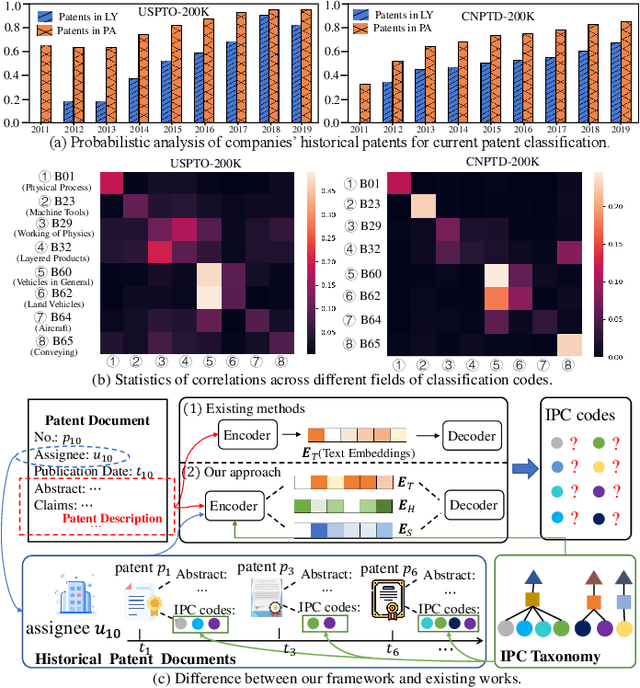

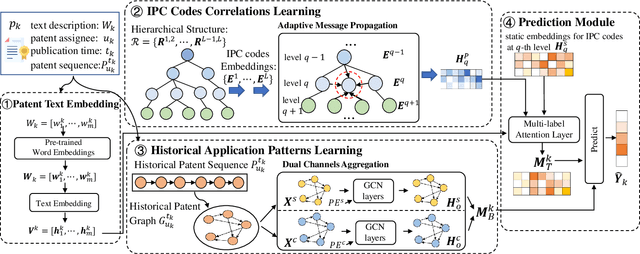
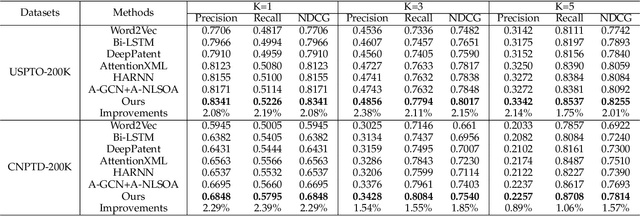
Abstract:Patent classification aims to assign multiple International Patent Classification (IPC) codes to a given patent. Recent methods for automatically classifying patents mainly focus on analyzing the text descriptions of patents. However, apart from the texts, each patent is also associated with some assignees, and the knowledge of their applied patents is often valuable for classification. Furthermore, the hierarchical taxonomy formulated by the IPC system provides important contextual information and enables models to leverage the correlations between IPC codes for more accurate classification. However, existing methods fail to incorporate the above aspects. In this paper, we propose an integrated framework that comprehensively considers the information on patents for patent classification. To be specific, we first present an IPC codes correlations learning module to derive their semantic representations via adaptively passing and aggregating messages within the same level and across different levels along the hierarchical taxonomy. Moreover, we design a historical application patterns learning component to incorporate the corresponding assignee's previous patents by a dual channel aggregation mechanism. Finally, we combine the contextual information of patent texts that contains the semantics of IPC codes, and assignees' sequential preferences to make predictions. Experiments on real-world datasets demonstrate the superiority of our approach over the existing methods. Besides, we present the model's ability to capture the temporal patterns of assignees and the semantic dependencies among IPC codes.
Event-based Dynamic Graph Representation Learning for Patent Application Trend Prediction
Aug 04, 2023Abstract:Accurate prediction of what types of patents that companies will apply for in the next period of time can figure out their development strategies and help them discover potential partners or competitors in advance. Although important, this problem has been rarely studied in previous research due to the challenges in modelling companies' continuously evolving preferences and capturing the semantic correlations of classification codes. To fill in this gap, we propose an event-based dynamic graph learning framework for patent application trend prediction. In particular, our method is founded on the memorable representations of both companies and patent classification codes. When a new patent is observed, the representations of the related companies and classification codes are updated according to the historical memories and the currently encoded messages. Moreover, a hierarchical message passing mechanism is provided to capture the semantic proximities of patent classification codes by updating their representations along the hierarchical taxonomy. Finally, the patent application trend is predicted by aggregating the representations of the target company and classification codes from static, dynamic, and hierarchical perspectives. Experiments on real-world data demonstrate the effectiveness of our approach under various experimental conditions, and also reveal the abilities of our method in learning semantics of classification codes and tracking technology developing trajectories of companies.
Cooperative guidance of multiple missiles: a hybrid co-evolutionary approach
Aug 15, 2022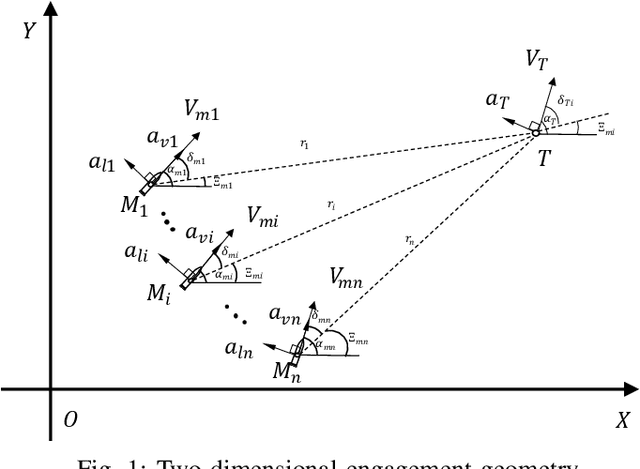
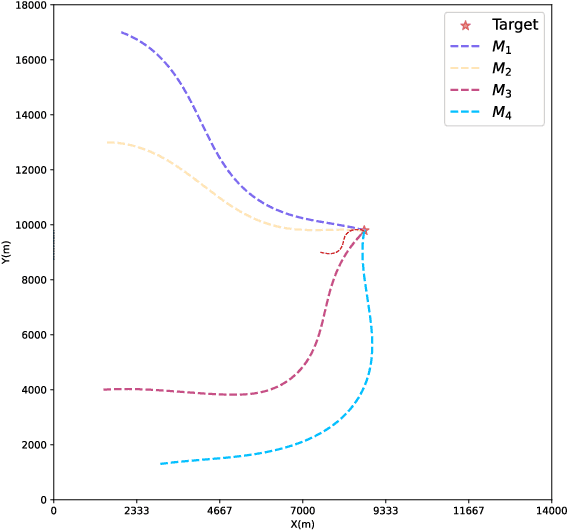
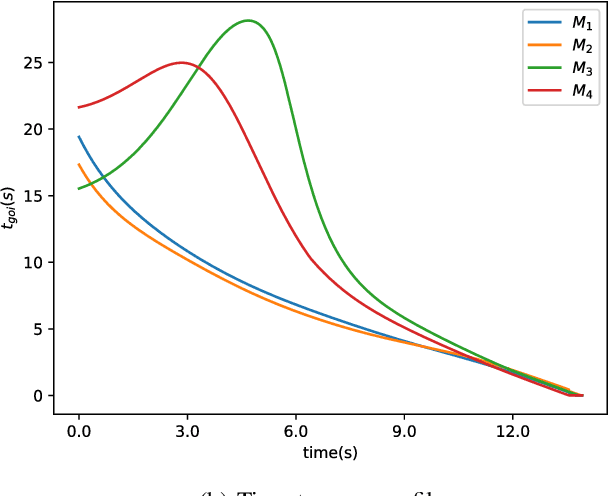
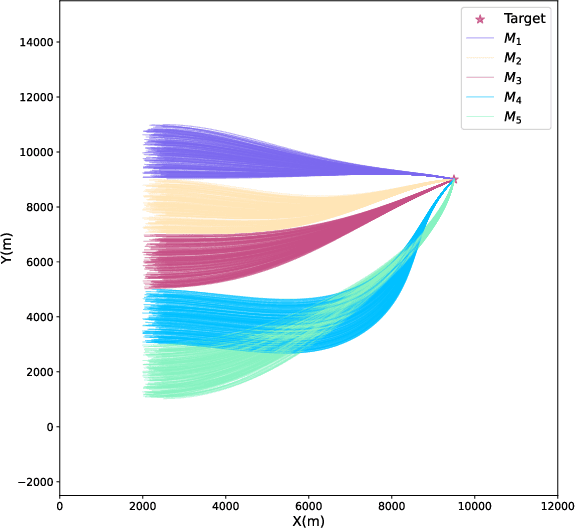
Abstract:Cooperative guidance of multiple missiles is a challenging task with rigorous constraints of time and space consensus, especially when attacking dynamic targets. In this paper, the cooperative guidance task is described as a distributed multi-objective cooperative optimization problem. To address the issues of non-stationarity and continuous control faced by cooperative guidance, the natural evolutionary strategy (NES) is improved along with an elitist adaptive learning technique to develop a novel natural co-evolutionary strategy (NCES). The gradients of original evolutionary strategy are rescaled to reduce the estimation bias caused by the interaction between the multiple missiles. Then, a hybrid co-evolutionary cooperative guidance law (HCCGL) is proposed by integrating the highly scalable co-evolutionary mechanism and the traditional guidance strategy. Finally, three simulations under different conditions demonstrate the effectiveness and superiority of this guidance law in solving cooperative guidance tasks with high accuracy. The proposed co-evolutionary approach has great prospects not only in cooperative guidance, but also in other application scenarios of multi-objective optimization, dynamic optimization and distributed control.
On the Subbagging Estimation for Massive Data
Feb 28, 2021



Abstract:This article introduces subbagging (subsample aggregating) estimation approaches for big data analysis with memory constraints of computers. Specifically, for the whole dataset with size $N$, $m_N$ subsamples are randomly drawn, and each subsample with a subsample size $k_N\ll N$ to meet the memory constraint is sampled uniformly without replacement. Aggregating the estimators of $m_N$ subsamples can lead to subbagging estimation. To analyze the theoretical properties of the subbagging estimator, we adapt the incomplete $U$-statistics theory with an infinite order kernel to allow overlapping drawn subsamples in the sampling procedure. Utilizing this novel theoretical framework, we demonstrate that via a proper hyperparameter selection of $k_N$ and $m_N$, the subbagging estimator can achieve $\sqrt{N}$-consistency and asymptotic normality under the condition $(k_Nm_N)/N\to \alpha \in (0,\infty]$. Compared to the full sample estimator, we theoretically show that the $\sqrt{N}$-consistent subbagging estimator has an inflation rate of $1/\alpha$ in its asymptotic variance. Simulation experiments are presented to demonstrate the finite sample performances. An American airline dataset is analyzed to illustrate that the subbagging estimate is numerically close to the full sample estimate, and can be computationally fast under the memory constraint.
 Add to Chrome
Add to Chrome Add to Firefox
Add to Firefox Add to Edge
Add to Edge